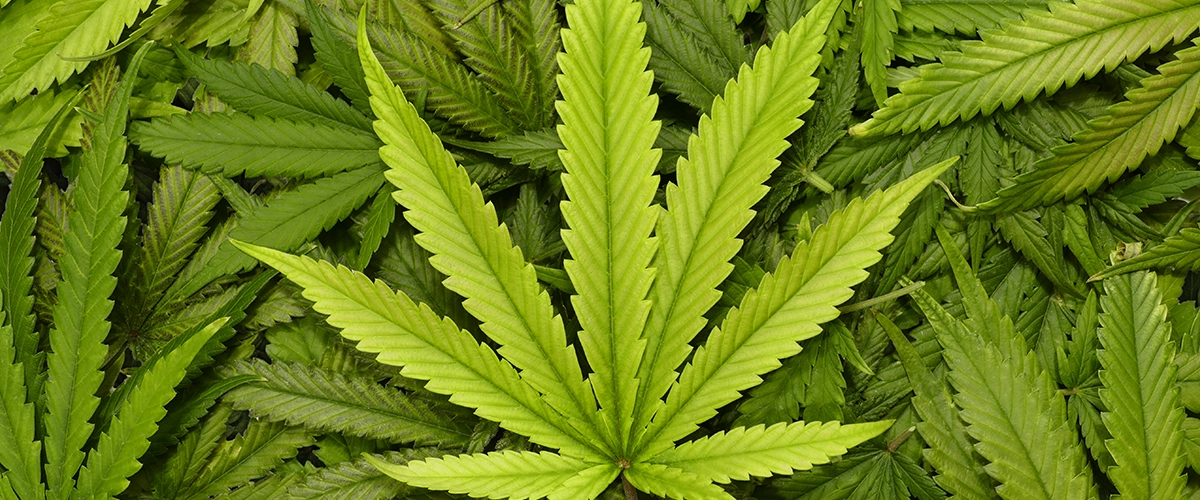No products in the cart.
The marijuana leaf, recognized worldwide, stands as an emblem of diverse cultural, medical, and social perceptions. This blog post delves into the effects, uses, legal aspects, and lesser-known facts surrounding the iconic marijuana leaf.
What does a marijuana leaf look like
A marijuana leaf is instantly recognizable due to its unique features. Typically, it showcases a palmate shape, resembling an outstretched hand with multiple leaflets stemming from a central point. These leaflets, usually serrated at the edges, create the iconic jagged appearance associated with marijuana. The color varies, often deep green, with some strains displaying hues of purple or even red. The leaf’s surface is covered in tiny hair-like structures called trichomes, which contain valuable compounds like cannabinoids and terpenes. These characteristics make the marijuana leaf stand out, making it easily distinguishable from other plant leaves.
Understanding the Marijuana Leaf:
The marijuana leaf, characterized by its distinct shape and serrated edges, holds a complex chemical makeup that interacts with the human body in unique ways. This interaction is primarily due to cannabinoids, the plant’s active compounds, more about marijuana.
Marijuana leaf image
A marijuana leaf image is a visual representation of the distinct palmate leaf with serrated edges. Often recognized by its iconic shape and vibrant green color, this image showcases the plant’s characteristic features, making it instantly recognizable to those familiar with cannabis.

Marijuana Effects
Marijuana, scientifically known as cannabis, is renowned for its psychoactive properties. The primary compound responsible for its effects is delta-9-tetrahydrocannabinol (THC). When consumed, THC interacts with our body’s endocannabinoid system, giving rise to a range of effects.
leafly how to consume marijuana
leafly THC Oil Uses
The Euphoria and Relaxation:
One of the most recognized effects of marijuana is the euphoria commonly referred to as the “high.” Users often experience a sense of relaxation and elation, which can lead to heightened creativity and introspection. This altered state of mind is at the core of marijuana’s appeal to recreational users.
Sensory Enhancement and Altered Perception:
Marijuana has the unique ability to intensify sensory experiences. Colors may appear more vibrant, music more immersive, and tastes more pronounced. Additionally, users often report altered time perception, where minutes can feel like hours, leading to a sense of time dilation.
Cognitive Effects and Creativity:
While marijuana’s effects can vary from person to person, some users note increased creativity and novel thought patterns. This cognitive shift can inspire artistic endeavors and problem-solving. However, it’s important to acknowledge that excessive consumption might hinder focus and short-term memory.
Potential Benefits of Marijuana Leaf Effects:
While discussions often center on the potential risks of marijuana, it’s equally important to recognize the potential benefits that its effects can offer.
Unlocking the Positive Effects:
Beyond its recreational allure, marijuana’s effects hold promise for various medical and wellness purposes. Understanding these potential benefits can shed light on the plant’s value beyond its psychoactive reputation.
Pain Relief and Relaxation:
One of the most well-known potential benefits of marijuana is its capacity to alleviate pain. Both THC and CBD, two major compounds in the plant, interact with the body’s endocannabinoid system to reduce pain sensations. This makes marijuana an option for individuals dealing with chronic pain conditions, such as arthritis or neuropathic pain.
Anxiety and Stress Reduction:
Marijuana’s effects can extend to mental health, with some users reporting reduced anxiety and stress levels. Certain strains, especially those higher in CBD, are sought after for their potential to induce relaxation without the intoxicating high associated with THC.
Support for Sleep Disorders:
Individuals struggling with sleep disorders might find relief in marijuana’s effects. Specific strains that induce relaxation and sedation could offer a natural alternative to traditional sleep aids.
Appetite Stimulation:
The “munchies,” a well-known side effect, can be particularly beneficial for those dealing with medical conditions that result in appetite loss. In cancer patients undergoing treatments like chemotherapy, marijuana’s ability to stimulate appetite can help maintain proper nutrition and overall well-being.
Managing Nausea and Vomiting:
Marijuana’s effects on reducing nausea and vomiting, especially in cancer patients undergoing chemotherapy, have shown promise in various studies. This could potentially enhance patients’ quality of life during their treatment journey.
Epilepsy and Seizure Control:
CBD, a non-psychoactive compound in marijuana, has garnered attention for its potential in reducing the frequency and severity of seizures in certain forms of epilepsy. This has led to the development of CBD-based medications approved by regulatory bodies, read more.

Potential Risks of Marijuana Leaf:
While marijuana offers various effects, it’s crucial to acknowledge that its use isn’t without potential risks. Understanding these risks can empower individuals to make informed choices and use marijuana responsibly.
Cognitive Impairment:
One of the primary concerns with marijuana use is its impact on cognitive function. Excessive and prolonged consumption, particularly during adolescence when the brain is still developing, may lead to memory problems, reduced attention span, and difficulties in problem-solving.
Psychological Dependency:
Although not as addictive as substances like opioids, marijuana can still lead to psychological dependence. This dependency might manifest as a perceived need to use marijuana to cope with stress, anxiety, or emotions, potentially interfering with daily life.
Mental Health Implications:
Individuals with a predisposition to mental health conditions should be cautious when considering marijuana use. Research suggests that marijuana could potentially exacerbate conditions such as anxiety, depression, and even increase the risk of developing psychosis in susceptible individuals.
Respiratory Concerns:
Smoking marijuana, like any form of smoking, can harm respiratory health. Inhaling smoke exposes the lungs to various toxins, which might lead to respiratory issues over time. Users might experience chronic bronchitis-like symptoms or other respiratory discomforts.
Impaired Driving and Safety:
Marijuana use can impair motor skills, coordination, and reaction times, which can significantly affect driving ability and overall safety. Mixing marijuana with driving or operating heavy machinery poses serious risks and is comparable to driving under the influence of alcohol.

Balancing Risk and Reward:
Understanding potential risks doesn’t imply that marijuana is inherently dangerous for everyone. It emphasizes the importance of informed decision-making and responsible use. Moderation, open communication, and awareness of personal health conditions play a crucial role.
Navigating Responsible Use:
Understanding the effects of marijuana is crucial for responsible use. Whether seeking relaxation, relief, or creative inspiration, moderation is key. It’s advisable to start with a low dose, especially for beginners, and be mindful of individual reactions.
Interesting Insights:
- Historical Roots: The marijuana leaf’s significance dates back to ancient civilizations, where it played roles in spiritual rituals, medical remedies, and cultural practices.
- Global Legalization: Attitudes toward the marijuana leaf are evolving globally, resulting in varied legal frameworks. While some regions fully embrace its recreational and medical use, others maintain strict regulations.
- Cultural Symbolism: Beyond its biochemical complexity, the marijuana leaf holds cultural importance, intertwined with counterculture movements, music, art, and societal shifts.
Conclusion:
The marijuana leaf, a symbol of intrigue and debate, holds a multifaceted identity. Embracing its potential benefits while acknowledging associated risks is essential. As societies navigate changing legal landscapes and deepen their understanding, the marijuana leaf’s impact on medicine, culture, and society remains a fascinating journey.
THC oil, short for tetrahydrocannabinol oil, is an extract derived from the cannabis plant. This concentrated substance contains high levels of THC, the psychoactive compound responsible for the characteristic effects associated with marijuana use. THC interacts with the body’s endocannabinoid system, leading to sensations like euphoria and relaxation. Beyond recreational use, THC oil has shown potential therapeutic benefits, including pain relief and managing certain medical conditions.
When considering where to buy pure THC oil, it’s crucial to prioritize reputable sources. Trusted vendors provide transparency about the extraction process, ensuring a high-quality product, check it out here.


Pingback: Highest THC Strains 2023 - K2 Drugs Best Quality Strains